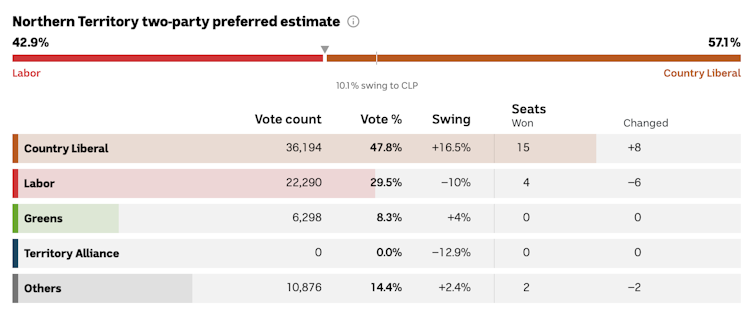The Northern Territory is a different place. On the day prior to this election, Speckles the Adelaide River crocodile was asked to predict the result of the election. He had replaced the previous crocodile, a spiv who got the 2016 and 2020 elections wrong.
Speckles decided Eva Lawler, the Labor Chief Minister, would win the election. Speckles was not the only prognosticator to get it wrong. I fear for his future.
The Country Liberal Party (CLP) has won majority government, returning to power after eight years in opposition. Double-digit swings against Labor have been recorded in some electorates. Lawler lost government and her own seat.
Instead, CLP Leader Lia Finocchiaro will become the Territory’s next Chief Minister and govern in majority.

A tale of two elections
Yesterday, effectively, there were two elections conducted for the NT Legislative Assembly. The first was in the bush electorates.
These are dominated by Aboriginal communities, often blighted by poverty, poor housing, inadequate medical services, failing educational services and the absence of employment opportunities: all the elements the Closing the Gap targets seek to address.
As is customary in Territory elections, these Indigenous communities voted Labor. Only once since self government in 1978 (in 2012) have they not done so.
However, Indigenous issues were hardly mentioned by politicians or the media in this election campaign.
Read more: NT election: promises for Indigenous people buckle under history's weight
This election was essentially an urban election played out mainly in Darwin-Palmerston and, to an extent, Alice Springs. It only paid some attention to Indigenous issues as a covert subtext to the broader community angst about crime.
Twice the expected swing
I predicted the CLP would get uneven swings, bigger in some instances (like in electorates that had suburbs where there were high levels of property crime, violence and public drunkenness).
Overall, I assumed the CLP Opposition would get a Territory-wide swing of about 4%–6%. I was wrong.
The overall swing to the CLP in the suburbs of Darwin was over twice that estimate. Several ministers, including Lawler, have lost their seats.
Lawler conceded defeat at 8:30pm, a full hour before losers in NT elections usually do so. That indicated the extent of the loss for Labor.
Counting will resume today but, on the trends, I expect at least four (possibly six) Labor Ministers will lose their seats.
As I predicted, independents have been elected in two seats: Yingiya Mark Guyula in Mulka (in northeast Arnhem Land) and Robyn Lambley in Araluen (in Alice Springs).
Other independents have done well, as in Johnston where a Teal-like (she actually wore purple) independent out-polled the Labor incumbent (although still behind the CLP).
Labor’s vote collapse
My interpretation of the collapse of the Labor vote is that it involves two elements.
One is the defection of weakly-aligned voters. These voters usually make up the swing in an election.
The other is that a fair proportion of Labor voters switched to the Greens. I have lauded Chief Minister Lawler for her tough campaign, but it’s possible some Labor voters were alienated by her right-ish switch and decided to vote Green, to remind Labor that it is supposed to be a progressive party.
However you interpret this election, it is definitely a landslide to the CLP. Comparatively, it’s not as bad for Labor as the anti-CLP landslide in 2016. Back then, Finocchiaro was the only CLP member reelected in the Greater Darwin area.
That 2016 election was consequential. Because Finocchiaro was the only CLP parliamentarian left in the Greater Darwin area, she eventually became CLP leader. The twists of fate mean that she is now Chief Minister.
The most interesting new development of this election was the rise of the Greens. They will feel greatly buoyed by this election, where in some seats they finally broke the 20% primary vote barrier to become serious players in Territory politics.
In my pre-poll analysis, I said this would be a good election to win because the NT economy will pick up next year.
In addition, Commonwealth expenditure in the NT is set to dramatically escalate. The billions of dollars worth of spending as part of remote housing and education deals struck with the Commonwealth, plus other large-scale spending programs, will start to come into play.
The Commonwealth is becoming invested in reversing Indigenous disadvantage in the Territory because the NT is the worst performer on the Closing The Gap targets.
This means continuing money for the NT and all but ensures the new CLP government will be re-elected in 2028.
Rolf Gerritsen does not work for, consult, own shares in or receive funding from any company or organisation that would benefit from this article, and has disclosed no relevant affiliations beyond their academic appointment.
This article was originally published on The Conversation. Read the original article.







